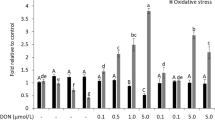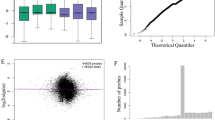Abstract
Quinocetone, a new quinoxaline 1,4-dioxide derivative used in food-producing animals in China, exerts genotoxic effects on HepG2 cells. It triggers significant cytotoxicity and genotoxicity in vitro, but the detailed mechanism by which quinocetone induces adverse biological effects is not yet known. We analyzed the mechanisms behind quinocetone intoxication by investigating oxidative stress based on non-enzymatic and enzymatic antioxidant activities, and by identifying differentially regulated genes of HepG2 cells exposed to quinocetone using polymerase chain reaction (PCR)-based suppression subtractive hybridization to illustrate the toxicity mechanism of quinocetone. Meanwhile, the characteristics of oxidative stress and differentially regulated genes induced by quinocetone metabolites, 1,4-bisdesoxyquinocetone and 3-methylquinoxaline-2-carboxylic acid, were investigated too. Results showed that quinocetone damaged the antioxidant defense abilities of HepG2 cells by reducing the activities of endogenous antioxidant enzymes, lowering glutathione concentration, and elevating malondialdehyde level. We identified 160 quinocetone-responsive genes that were associated with cell proliferation, glucose metabolism, oxidative stress, and apoptosis, such as NAD(P)H dehydrogenase, quinone 1; and prolyl 4-hydroxylase, beta polypeptide. The expressions of some differentially regulated genes were confirmed by real-time reverse transcription-polymerase chain reaction. However, quinocetone metabolites showed little effects on HepG2 cells. These results showed that reactive oxygen species were the key mediators of quinocetone cytotoxicity in HepG2 cells and that c-MYC-dependent activation of the mitochondrial apoptotic pathway may be associated with quinocetone-induced toxicity.





Similar content being viewed by others
References
Ahmad IM, Aykin-Burns N, Sim JE, Walsh SA, Higashikubo R, Buettner GR, et al. Mitochondrial O2*- and H2O2 mediate glucose deprivation-induced stress in human cancer cells. J Biol Chem. 2005;280:4254–63.
Averill-Bates DA, Przybytkowski E. The role of glucose in cellular defences against cytotoxicity of hydrogen peroxide in Chinese hamster ovary cells. Arch Biochem Biophys. 1994;312:52–8.
Azqueta A, Arbillaga L, Pachón G, Cascante M, Creppy EE. López de Cerain A. A quinoxaline 1,4-di-N-oxide derivative induces DNA oxidative damage not attenuated by vitamin C and E treatment. Chem Biol Interact. 2007;168:95–105.
Bates GJ, Nicol SM, Wilson BJ, Jacobs AM, Bourdon JC, Wardrop J, et al. The DEAD box protein p68: a novel transcriptional coactivator of the p53 tumour suppressor. EMBO J. 2005;24:543–53.
Calviello G, Piccioni E, Boninsegna A, Tedesco B, Maggiano N, Serini S, et al. DNA damage and apoptosis induction by the pesticide Mancozeb in rat cells: involvement of the oxidative mechanism. Toxicol Appl Pharmacol. 2006;211:87–96.
Candé C, Vahsen N, Kouranti I, Schmitt E, Daugas E, Spahr C, et al. AIF and cyclophilin A cooperate in apoptosis-associated chromatinolysis. Oncogene. 2004;23:1514–21.
Carta A, Corona P, Loriga M. Quinoxaline 1,4-dioxide: a versatile scaffold endowed with manifold activities. Curr Med Chem. 2005;12:2259–72.
Chang BY, Conroy KB, Machleder EM, Cartwright CA. RACK1, a receptor for activated C kinase and a homolog of the beta subunit of G proteins, inhibits activity of src tyrosine kinases and growth of NIH 3 T3 cells. Mol Cell Biol. 1998;18:3245–56.
Chen Q, Tang S, Jin X, Zou J, Chen K, Zhang T, et al. Investigation of the genotoxicity of quinocetone, carbadox and olaquindox in vitro using Vero cells. Food Chem Toxicol. 2009;47:328–34.
Coleman MC, Asbury CR, Daniels D, Du J, Aykin-Burns N, Smith BJ, et al. 2-deoxy-D-glucose causes cytotoxicity, oxidative stress, and radiosensitization in pancreatic cancer. Free Radic Biol Med. 2008;44:322–31.
Dragan YP, Bidlack WR, Cohen SM, Goldsworthy TL, Hard GC, Howard PC, et al. Implications of apoptosis for toxicity, carcinogenicity, and risk assessment: fumonisin B(1) as an example. Toxicol Sci. 2001;61(1):6–17.
Du H, Huang X, Wang S, Wu Y, Xu W, Li M. PSMA7, a potential biomarker of diseases. Protein Pept Lett. 2009;16:486–9.
Feo S, Arcuri D, Piddini E, Passantino R, Giallongo A. ENO1 gene product binds to the c-myc promoter and acts as a transcriptional repressor: relationship with Myc promoter-binding protein 1 (MBP-1). FEBS Lett. 2000;473:47–52.
Forsythe HL, Jarvis JL, Turner JW, Elmore LW, Holt SE. Stable association of hsp90 and p23, but Not hsp70, with active human telomerase. J Biol Chem. 2001;276:15571–4.
Gil P, Fariñas F, Casado A, López-Fernández E. Malondialdehyde: a possible marker of ageing. Gerontology. 2002;48(4):209–14.
Griffith OW. Mechanism of action, metabolism, and toxicity of buthionine sulfoximine and its higher homologs, potent inhibitors of glutathione synthesis. J Biol Chem. 1982;257(22):13704–12.
Huang XJ, Ihsan A, Wang X, Dai MH, Wang YL, Su SJ, et al. Long-term dose-dependent response of Mequindox on aldosterone, corticosterone and five steroidogenic enzyme mRNAs in the adrenal of male rats. Toxicol Lett. 2009;191:167–73.
Huang XJ, Zhang HH, Wang X, Huang LL, Zhang LY, Yan CX, et al. ROS mediated cytotoxicity of porcine adrenocortical cells induced by QdNOs derivatives in vitro. Chem Biol Interact. 2010;185:227–34.
Ihsan A, Wang X, Zhang W, Tu H, Wang Y, Huang L, et al. Genotoxicity of quinocetone, cyadox and olaquindox in vitro and in vivo. Food Chem Toxicol. 2013;59:207–14.
Jin X, Chen Q, Tang SS, Zou JJ, Chen KP, Zhang T, et al. Investigation of quinocetone-induced genotoxicity in HepG2 cells using the comet assay, cytokinesis-block micronucleus test and RAPD analysis. Toxicol In Vitro. 2009;23:1209–14.
Joza N, Susin SA, Daugas E, Stanford WL, Cho SK, Li CY, et al. Essential role of the mitochondrial apoptosis-inducing factor in programmed cell death. Nature. 2001;410:549–54.
Kim JW, Dang CV. Multifaceted roles of glycolytic enzymes. Trends Biochem Sci. 2005;30:142–50.
Klefstrom J, Verschuren EW. Evan G c-Myc augments the apoptotic activity of cytosolic death receptor signaling proteins by engaging the mitochondrial apoptotic pathway. J Biol Chem. 2002;277:43224–32.
Knasmüller S, Mersch-Sundermann V, Kevekordes S, Darroudi F, Huber WW, Hoelzl C, et al. Use of human-derived liver cell lines for the detection of environmental and dietary genotoxicants; current state of knowledge. Toxicology. 2004;198:315–28.
Kohda T, Asai A, Kuroiwa Y, Kobayashi S, Aisaka K, Nagashima G, et al. Tumour suppressor activity of human imprinted gene PEG3 in a glioma cell line. Genes Cells. 2001;6:237–47.
Li GY, Kim M, Kim JH, Lee MO, Chung JH, Lee BH. Gene expression profiling in human lung fibroblast following cadmium exposure. Food Chem Toxicol. 2008;46:1131–7.
Münz M, Kieu C, Mack B, Schmitt B, Zeidler R, Gires O. The carcinoma-associated antigen EpCAM upregulates c-myc and induces cell proliferation. Oncogene. 2004;23:5748–58.
Nath KA, Ngo EO, Hebbel RP, Croatt AJ, Zhou B, Nutter LM. alpha-Ketoacids scavenge H2O2 in vitro and in vivo and reduce menadione-induced DNA injury and cytotoxicity. Am J Physiol. 1995;268(1 Pt 1):C227–36.
Saretzki G. Telomerase, mitochondria and oxidative stress. Exp Gerontol. 2009;44(8):485–92.
Walczak H, Degli-Esposti MA, Johnson RS, Smolak PJ, Waugh JY, Boiani N, et al. TRAIL-R2: a novel apoptosis-mediating receptor for TRAIL. EMBO J. 1997;16:5386–97.
Wang X, Zhang W, Wang Y, Peng D, Ihsan A, Huang X, et al. Acute and sub-chronic oral toxicological evaluations of quinocetone in Wistar rats. Regul Toxicol Pharmacol. 2010;58:421–7.
Wang X, Huang XJ, Ihsan A, Liu ZY, Huang LL, Zhang HH, et al. Metabolites and JAK/STAT pathway were involved in the liver and spleen damage in male Wistar rats fed with mequindox. Toxicology. 2011;280(3):126–34.
Yang W, Fu J, Xiao X, Yan H, Bao W, Wang D, et al. Quinocetone triggers oxidative stress and induces cytotoxicity and genotoxicity in human peripheral lymphocytes of both genders. J Sci Food Agric. 2013;93:1317–25.
Yoshimura H, Nakamura M, Koeda T, Yoshikawa K. Mutagenicities of carbadox and olaquindox-growth promoters for pigs. Mutat Res. 1981;90:49–55.
Zhang S, Tang S, Yang C, Shen J, Wang Z, Li Y, et al. Analysis of quinocetone and its four metabolites in swine liver by ultra-performance liquid chromatography quadrupole time-of-flight mass spectrometry. J Anal Bioanal Techniques. 2010;1:1–6.
Zhang T, Tang SS, Jin X, Liu FY, Zhang CM, Zhao WX, et al. c-Myc influences olaquindox-induced apoptosis in human hepatoma G2 cells. Mol Cell Biochem. 2011;354:253–61.
Zhang K, Ban M, Zhao Z, Zheng H, Wang X, Wang M, et al. Cytotoxicity and genotoxicity of 1,4-bisdesoxyquinocetone, 3-methylquinoxaline-2-carboxylic acid (MQCA) in human hepatocytes. Res Vet Sci. 2012;93:1393–401.
Zhang C, Wang C, Tang S, Sun Y, Zhao D, Zhang S, et al. TNFR1/TNF-α and mitochondria interrelated signaling pathway mediates quinocetone-induced apoptosis in HepG2 cells. Food Chem Toxicol. 2013;62:825–38.
Zou J, Chen Q, Tang S, Jin X, Chen K, Zhang T, et al. Olaquindox-induced genotoxicity and oxidative DNA damage in human hepatoma G2 (HepG2) cells. Mutat Res. 2009;676:27–33.
Conflict of interest
The authors declare that there is no conflict of interest involved in this study.
Funding information
This work was supported by the Youth Science Funds of National Natural Science Foundation of China (30901087). This project is also supported in part by Special Fund for Agro-scientific Research in the Public Interest (201303038-1).
Author information
Authors and Affiliations
Corresponding authors
Rights and permissions
About this article
Cite this article
Zhang, K., Zheng, W., Zheng, H. et al. Identification of oxidative stress and responsive genes of HepG2 cells exposed to quinocetone, and compared with its metabolites. Cell Biol Toxicol 30, 313–329 (2014). https://doi.org/10.1007/s10565-014-9287-0
Received:
Accepted:
Published:
Issue Date:
DOI: https://doi.org/10.1007/s10565-014-9287-0




